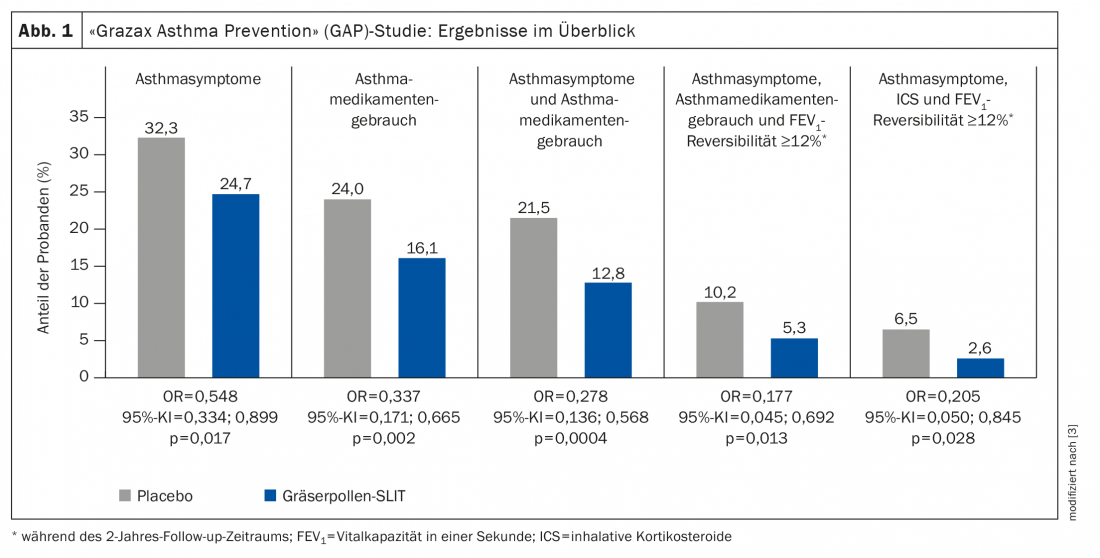The use of allergen-specific immunotherapy – also known as hyposensitization – is used for the causal treatment of IgE-mediated allergies. Studies indicate that in children with allergic rhinitis, sublingual immunotherapy (SLIT) can also prevent floor switching in terms of a secondary preventive therapy effect. Current scientific research indicates that, if possible, it should be started at an early age to counteract the development of allergic asthma.
In grass pollen allergy, inhalant allergens enter not only the nose but also the bronchial tubes. When inflammation of the upper respiratory tract moves to the lower respiratory tract, it is also referred to as a “floor change.” Patients with allergic rhinitis have a 3.5-fold higher relative risk of developing bronchial asthma within less than 10 years [1]. A large number of children with untreated hay fever develop asthma before adulthood. The efficacy of sublingual immunotherapy (SLIT) for allergic rhinoconjunctivitis caused by grass pollen has been extensively documented in adults and children [2]. Aspects of secondary prevention, in particular the reduction of new sensitizations and the reduction of the risk of asthma, are important reasons for the decision to initiate treatment in childhood and adolescence. In the randomized-controlled double-blinded “Grazax Asthma Prevention” (GAP) study, a preventive effect of sublingual immunotherapy with regard to asthma development was demonstrated in 5-12-year-old children with allergic rhinoconjunctivitis ( n=812 ) (Fig. 1) [3]. The study period included 3 years of SLIT therapy and 2-year follow-up.
The results of a recent “Real World” study presented at this year’s EEACI Annual Meeting also suggest that this age group benefits most from the preventive effects of allergen-specific immunotherapy/SLIT [4].

Secondary prevention benefit of SLIT greatest in 5-12 year olds
Retrospective cohort analysis of a German longitudinal prescription database examined the age-specific effects of ≥2 years of allergen immunotherapy (AIT) on the development of bronchial asthma in patients with allergic rhinitis [4]. Here, an AIT group treated with grass/cereal pollen AIT (including 7 of different SLIT/SCIT products) was compared with a control group receiving symptomatic treatment only (non-AIT group). Logistic regression analyses compared prescriptions for new asthma medications in both groups as an indicator of disease incidence.
10 033 and 29 774 patients with allergic rhinitis without asthma were analyzed for age-specific effects in the AIT and non-AIT groups, respectively. The age distribution was as follows: 5-12 years (33%), 13-17 years (11%), 18-35 years (30%), 36-50 years (26%). Across all age groups, 13.4% developed asthma during or after treatment cessation in the AIT group and 14.6% in the non-AIT group. Overall, although the AIT-treated group did not have a lower risk of new asthma medication prescriptions (odds ratio [OR]: 1.001, p=0.989), the age-specific analyses indicate that the preventive benefit of AIT is age-dependent. Accordingly, the probability of remaining asthma-free is higher in the AIT group among those under 35 years of age than in the control group, which was not the case in the 35-50 age group. The 5-12 year olds benefited most from preventive effects; here, the risk of a new asthma medication prescription was found to be significantly reduced in the AIT group compared to the control group (Fig. 2) [4].
Further analysis revealed that the AIT application form and allergy status had relevance. Thus, only patients treated with SLIT (n=1833) were found to be significantly less likely to be prescribed a new asthma medication across all age groups, and this effect was most pronounced in 5-12 year olds (OR: 0.690, p=0.006). Another finding was that monoallergic patients benefited more than patients with multiple allergies.
Principle of allergen-specific immunotherapy: immune system is trained
In summary, the present study data show a trend toward age-specific effects in grass pollen allergic patients in terms of reducing the risk of having an indication for an asthma medication during and after SLIT therapy. Children and monoallergic adolescents seem to benefit most from this secondary prevention effect. It may therefore be advisable to start SLIT at an early age. The principle of AIT is that administration of allergen extracts activates specific blocking antibodies, tolerance-inducing cells, and second messengers that prevent further amplification of the immune response triggered by allergens, block the specific immune response, and dampen the inflammatory response in tissues [2]. In sublingual immunotherapy (SLIT), hyposensitization takes the form of tablets that the allergy sufferer usually takes daily. In subcutaneous immunotherapy (SCIT), the allergen is injected under the skin by an allergist. Initially, patients receive only a very small amount of the allergen, which activates certain components of the immune system involved in the exuberant immune response [5]. In the course of further AIT therapy, the amount of allergen is gradually increased until finally the highest dose is reached. As a result, tolerance to the allergen in question can be achieved in the long term, so that the allergic reaction is much weaker when contact occurs again. Overall, AIT should be conducted over at least three years. If the allergy is caused by pollen, hyposensitization usually takes place several months before the pollen season begins.
Congress: EEACI Annual Meeting
Literature:
- Shaaban R, et al: Rhinitis and onset of asthma: a longitudinal population-based study. Lancet 2008; 372: 1049-1057.
- Pfaar O, et al: Guideline on allergen-specific immunotherapy in IgE-mediated allergic diseases: S2k guideline of the German society for allergology and clinical immunology (DGAKI), GPA, AeDA, ÖGAI, SGAI, DDG, DGHNO-KHC, DGKJ, GPP, DGP, BV-HNO, BVKJ, BDP, BVDD. Allergo J Int 2014; 23: 282-319.
- Valovirta E, et al: GAP investigators. Results from the 5-year SQ grass sublingual immunotherapy tablet asthma prevention (GAP) trial in children with grass pollen allergy. J Allergy Clin Immunol 2018; 141(2): 529-538.e13.
- Zieglmayer P: 100048 – Age-specific effects of grass pollen allergen immunotherapy in reducing the risk for new onset asthma: a real world dataset analysis, 01-03/07/2022.
- Lung Information Service: Hyposensitization, www.lungeninformationsdienst.de, (last accessed Aug. 17, 2022).
HAUSARZT PRAXIS 2022; 17(9): 28-30












